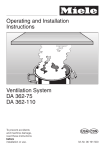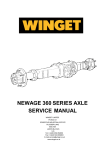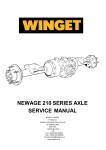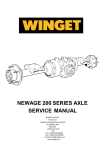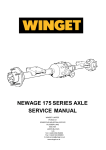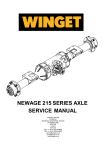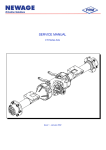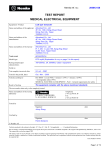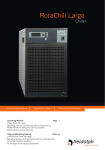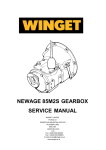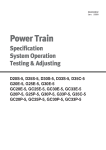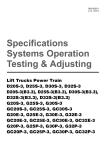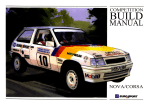Download Pelco NEWAGE 410 Automobile Parts User Manual
Transcript
NEWAGE 410 SERIES AXLE SERVICE MANUAL WINGET LIMITED PO BOX 41 EDGEFOLD INDUSTRIAL ESTATE PLODDER LANE BOLTON LANCS BL4 OLS U.K. Tel:++44(0)1204 854650 Fax:++44(0)1204 854663 E-mail [email protected] www.winget.co.uk CONTENTS INTRODUCTION GENERAL DESCRIPTION IDENTIFICATION GENERAL SERVICE INFORMATION EXPLODED VEIW/PARTS LIST SECTION A PINION CARTRIDGE SECTION B DIFFERENTIAL ASSEMBLY SECTION C PLANET CARRIER ASSEMBLY SECTION D HUB, AXLE STUB AND AXLE ARM ASSEMBLY SECTION E BRAKES SECTION F SETTING UP CROWNWHEEL AND PINION SECTION G SPIRAL BEVEL GEAR TOOTH CONTACTS Section 1 INTRODUCTION Introduction Winget Limited gratefully acknowledge the assistance given by Newage Transmissions Limited in the preparation of this manual, however neither Winget Limited or Newage Transmissions can be held responsible for any errors or ommissions. The procedures described within this manual should enable experienced service personel to strip, repair and re-build Newage 410 series axles fitted to Winget 4S range site dumpers in a safe and competant manner. The procedures are not intended to be used by personnel who are unfamiliar with the product or mechanically inexperienced. It is assumed that personnel are aware of the Health and Safety Regulations which should be applied but the following should act as a reminder. Whenever possible any repairs or service should be carried out in a clean environment. If work must be carried out on site or in the field steps should be taken to ensure that dirt or foreign materials cannot enter the assembly. Ensure all work tools are in good condition and only use the correct tool for the job in hand. Always wear safety spectacles when using soft or hard faced hammers, chisels, drifts or when using air tools. Wear safety spectacles when cleaning components or when grinding. Do not misuse air lines and be aware of the damage compressed air can cause if misused. Always make sure lifting equipment is in good condition and the Safe Working Load exceeds the weight of the component to be lifted. Always use suitable supports i.e. axle stands or baulks of timber in conjuction with hydraulic jacks etc. Never rely on hydraulic jacks alone to support a machine. Be aware of hot surface temperatures and take care when draining hot oils. Always dispose of waste oils in accordance with local and national regulations. Whenever possible always disconnect the battery or battery isolator when working on the machine to prevent electrical shorts and unauthorised starting. Refer to the operators handbook for a guide to the correct sequence for assembling components and sub-assemblies. Oils, fuels, silicone sealer etc can cause skin diseases if allowed to contaminate the skin. Always apply barrier creams, wear suitable protective clothing or when contamination is unavoidable clean the area with soap and water as soon as possible. Do not use thinners or other solvents to clean skin. Health and Safety is a matter of common sense. If common sense is applied correctly the risk of accidents can be reduced. Spares for Newage Axles fitted to Winget Equipment can only be obtained from Winget Limited or one of our authorised distributors and not from Newage Transmissions Limited. Always quote your machines serial number and model together with axle serial number and model when ordering spare parts. 410 Series axles are designed to operate under arduous conditions and providing they are regularly and correctly maintained they will provide long trouble free service. Whilst every effort is made to ensure the contents of this manual are accurate Winget Limited and Newage Transmissions reserve the right to alter specification without prior notification and certain sections of this manual may then no longer apply. Section 2 GENERAL DESCRIPTION General Description The 410 series is a double reduction drive axle with integral long life oil immersed multiplate disc brakes. Housed within the central housing is the spiral bevel crownwheel and pinion assembly. The crownwheel is mounted on a four pinion differential. The planetary reduction gears and brake plates are housed within the ends of the axle arms. The axle half shafts are fully floating and the wheel hubs run on opposed taper roller bearings. The approximate weight is 220KG (485lb). Section 3 IDENTIFICATION Identification A plate is attached to the centre housing of each axle on which are stamped details of the axle specification (see illustration below) and the axle serial number. If you require spares, both numbers on the plate should be quoted together with the machine model and serial number. The model number allocated to each axle describes the basic specification as follows:Axle Model Series 410 Fixed Pads R Rigid Drive F Code Number 14 Reduction Ratio 14.8:1 W131 Section 4 GENERAL SERVICE INFORMATION General Service Information Routine Maintenance Check Interval For oil leaks around joints and seals Weekly/50 hours Wheel nut tightness Daily/8 hours Hub bearing adjustment 12 Monthly/1000 hours Axle arm/centre case bolts Weekly/50 hours Halfshaft securing nuts Weekly/50 hours Propshaft nuts and bolts Weekly/50 hours Brake pipe connections Weekly/50 hours Lubricants The oils used must have the correct additives to be compatible with the mineral oil braking system, therefore, only those lubricants shown below or their direct equivalents must be used. Mobil Fluid 422 Agricastrol AS Special Esso Torque Fluid 56 or 62 Gulf Universal Tractor Oil Total Universal Plant Oil Total Transmission MP The oil is added via the combined filler/level plug located in the face of the centre housing on the opposite face from the input flange. THE OIL CAPACITY IS APPROXIMATELY 6.25 LITRES (11 PINTS) Greases The oils seals in the areas listed below should be packed with grease whenever a major overhaul or a repair to one of these areas is carried out. 1) Hub Seal - between the V Ring Seal and Hub Oil Seal. 2) Pinion Oil Seals Using the one of the following greases or their equivalents. Mobil Grease MP Esso Beacon 2 Total Multis EP2 Brake Fluid The oil immersed brakes are operated using a mineral hydraulic fluid. On no account must a vegetable based brake fluid be used otherwise all braking system seals will be damaged. Whenever the brakes are serviced it is essential that the cylinder bores, pistons and seals are cleaned before assembly and lubricated using one of the following mineral oils or their equivalent. Total Azzola ZS46 Total Azzola ZS22 Shell Tellus 27 Mobil DTE 24 Esso Nuto H32 Liquid Sealants On assembly the following mating surfaces should be coated as indicated. Under no circumstances should Silicone RTV Compound be used on the Pinion Housing/Cartridge or the Axle Arm to Case Joints. Pinion Housing/Cartridge to Maincase Hermatite Axle Arm to Main Centre Housing Hermatite Stub Axle to Axle Arm (Where applicable) Hermatite Halfshaft to Hub Compound Silicone RTV Tightening Torques Description Torque Kpm (lbft) Differential Assembly Nuts & Bolts 7.8 56 Brake Cylinder to Maincase Capscrews 5.8 42 Pinion Cartridge to Maincase Setscrews 5.8 42 Axle Arm to Maincase Bolts 5.8 42 Halfshaft to Hub Nuts 16 115 Stub Axle to Axle Arm Nuts and Bolts 25 180 Hub Assembly Ring Nut 14 100 Wheel Nut 5/8 BSF 25 180 Wheel Nut 18mm 28 200 Brake Pipe Adaptors 2.8 20 19 35 55 84 168 294 696 17 30 48 73 146 255 606 5/16 3/8 7/16 1/2 5/8 3/4 1" 515 217 124 62 40 26 829 349 200 100 65 41 23 11 7 14 NOM. MIN. 953 402 230 115 75 47 26 13 MAX. GRADE V 704 297 170 85 55 35 19 10 MIN. 1004 423 243 121 79 50 28 14 NOM. 1155 487 279 140 91 58 32 16 MAX. GRADE X NOM. 10 21 38 59 91 183 319 757 SIZE 1/4 5/16 3/8 7/16 1/2 5/8 3/4 1" 871 367 210 105 68 43 24 12 643 271 156 78 51 32 18 9 1036 437 250 125 81 52 28 14 1191 502 288 144 94 59 33 16 MAX. NOM. MAX. MIN. GRADE V GRADE S 881 371 213 106 69 44 24 12 MIN. 1255 529 303 152 99 63 35 17 NOM. 1443 609 349 174 113 72 40 20 MAX. GRADE X IMPERIAL IN POUNDS-FEET (LBF-FT) COATED THREADS, ZINC & ZINC PASSIVATED 10 8 1/4 MAX. NOM. SIZE GRADE S IMPERIAL IN POUNDS-FEET (LBF-FT) PLAIN THREADS 1067 450 258 129 84 53 29 15 MIN. 853 360 206 103 67 43 23 12 MIN. 24 20 16 12 10 8 6 5 SIZE 24 20 16 12 10 8 6 5 SIZE 770 450 210 96 56 28 11 7 MAX. 570 340 160 72 40 20 8 5 MIN. 920 560 280 115 67 33 14 8 NOM. 1040 640 320 130 77 37 16 9 MAX. GRADE 10.9 800 480 240 100 57 29 12 7 MIN. 1171 677 347 140 80 40 17 10 NOM. 1347 779 399 161 92 47 19 11 MAX. GRADE 12.9 868 502 257 104 59 30 12 7 NOM. 998 577 296 119 68 34 14 8 MAX. GRADE 8.8 737 426 219 88 50 25 10 6 MIN. 1220 706 362 146 84 42 17 10 NOM. 1403 811 416 168 96 48 20 12 MAX. GRADE 10.9 1037 600 307 124 71 36 15 9 MIN. 1464 847 434 175 100 51 21 12 NOM. 1684 974 499 201 115 58 24 14 MAX. GRADE 12.9 METRIC IN NEWTON/METRES (Nm) COATED THREADS, ZINC & ZINC PASSIVATED 694 401 206 83 48 24 10 6 NOM. GRADE 8.8 METRIC IN NEWTON/METRES (Nm) PLAIN THREADS NEWAGE TRANSMISSIONS: TORQUE VALUES FOR FASTENERS WITH CLEAN & DRY THREADS 1244 720 369 149 85 43 18 10 MIN. 995 576 295 119 68 34 14 8 MIN. Section A PINION HOUSING Servicing the Pinion Cartridge Assembly Section A Place a suitable container below the axle drain plug underneath the axle centre housing, remove the plug and drain the oil. Dispose of the oil safely in accordance with local bylaws and national regulations. Remove the setscrews securing the pinion cartridge to the centre housing and lift off the assembly. The cartridge is located to the centre housing on dowels and will require carefully prising free using a small pry bar or similar suitable tool. Take care not to damage or lose the shims fitted between the cartridge and centre housing. Prevent the flange from turning and undo and remove the self locking nut and flat washer securing the flange to the pinion. Using a suitable puller or drift remove the flange and gently drift the pinion shaft out through the cartirdge. Take care to avoid damaging the gear teeth, splines or threads. Prise the oil seals out of the cartridge, slide the old collapsed spacer off the shaft and discard the spacer. Note: A new spacer should always be fitted. Inspect the bearings for wear or damage, check the teeth on both the crownwheel and pinion and make a visual check through the differential of the “wheels”. If the front bearing race on the shaft needs replacing use a suitable bearing puller to avoid damaging the pinion shaft. If the outer cones need replacing they can easily be drifted out of each end of the cartridge. Important: If new pinion bearings are fitted check the crownwheel/pinion backlash. See Section F Crownwheel Pinion Set Up. To re-assemble the cartridge reverse the above procedure fitting a new collapsible spacer, install the pinion shaft through the innermost bearing cone and fit the rear bearing over the pinion shaft. Carefully fit the new oil seals and pack with one of the recommended greases. Refit the flange, coat the inner surface of the flat washer with silicone sealer and loosely refit the washer and self locking nut. Prevent the flange from turning and tighten the nut until the spacer begins to collapse and all the end float between the pinion bearing is taken up but without pre-loading the bearings. Slowly continue to tighten the nut, frequently checking the preload, until a preload of 4.56.5Kg (9.9-14.3lbs) for new bearings or 2.2-3.50Kg(4.9-7.7lbs) for used bearings is obtained. The preload is measued by winding a length of string round the flange and measuring the load required to turn the flange with a spring balance. Care should be excercised when tightening the pinion nut otherwise the required preload will quickly be exceeded. If the old bearings have been reused coat the mating surface of the pinion cartridge and centre housing with the recommended sealant and fit the original shimpack. Refit the cartridge onto the centre case. If new bearings have been fitted refer to Section F. Refit the drain plug and tighten. Remove the combined filler/level plug located midway up the rear of the centre housing and refill the axle with oil. Refit and tighten the level plug. Section B DIFFERENTIAL ASSEMBLY Servicing the Crownwheel and Differential Assembly Section B Refer to Sections A, D and E and remove the pinion cartridge, axle arm assemblies, sungears and brake plates. Withdraw the brake pistons and discard the “O” rings. Remove the cap headed screws and brake pipe adaptors retaining the brake cylinders into the centre casing, mark both the cylinders and casing so that the cylinders can be refitted in their respective ends of the casing on re-assembly. Stand the maincase on one cylinder end and carefully withdraw the now upper cylinder, if necessary the cylinders can be “jacked” out of the casing by fitting two setscrews into the threaded holes provided in each cylinder. Lift out the differential assembly and turn the centre casing over, withdraw the remaining brake cylinder. Note which end of the centre casing the crownwheel is located. Locating the crownwheel into the opposite end of the casing from which it was removed will result in the axle rotation being reversed. Important: Unless the brake cylinders, differential bearings, differential casing halves or maincase are to be replaced do not disturb the adjusting ring nuts located in the centre of the brake cylinders otherwise the differential bearing preload and crownwheel/pinion backlash will need resetting as described in Section F. Remove the nuts and bolt securing the crownwheel and the two halves of the differential casing together, lift off the crownwheel and separate the two halves of the casing exposing the differential spiders, pinion and wheels. Examine each component for wear and replace as necessary. Re-assemble taking care that all components are kept clean, align the indent marks on the casing halves and torque the nuts and bolts to:7.8Kpm (56lbft) Clean the mating surfaces of the brake cylinders and main casing and coat the surfaces with one of the recommended sealants. Reassemble one cylinder into its respective end of the casing and stand the casing on that end. Carefully lower the differential assembly into the centre casing and install the second brake cylinder. Secure with the cap head screws and the brakepipe adaptors. Lubricate the pistons, new seals and cylinders with clean hydraulic oil (not brake fluid) and assemble the pistons into the cylinders. Refer to Sections A, D and E and re-assemble the axle. Section C PLANET CARRIER ASSEMBLY Servicing the Planet Carrier Assembly Section C To gain access to the planet carrier refer to Sections D and E and remove the axle arm, sun gear and brake plates. Withdraw the brake spacer plate from within the axle arm and lift out the planet carrier assembly. Check the teeth on the planet gears, sun gears and annulus gears for wear. The planet gears should run freely on the planet pins without excessive radial play. To dismantle the planet carrier knock the spring dowels into the planet pins and lightly drift the planet pins out of the carrier. Remove the thrust washers, planet gears and needle bearing. The axle shaft thrust washer is retained by a circlip which can be removed to allow inspection of the washer. Inspect all the individual components for wear and replace as necessary. Before re-assembling the planet carrier remove the old spring dowel pins from the planet pins and ensure new spring dowel pins are fitted on assembly. If necessary the annulus, which is retained by the dowels, can be withdrawn from the axle arm. If the annulus is replaced the dowels should also be replaced. Ensure the annulus is fitted squarely into the axle on re-assembly. Locate the planet carrier assembly back into the axle arm engaging the teeth on the annulus gear. Refit the brake spacer plates. Refit the brake disc plates and sun gear as described in Section E. Refit the axle arm as decribed in Section D. Refit the drain plug, remove the combined filler/level plug and top up the axle oil. Section D AXLE ARM & HUB ASSEMBLY Hub, Stub Axle and Axle Arm Assembly Section D The Hub, Halfshaft and Stub Axle can be serviced with the Axle in situ on the machine. The Hub Assembly Remove the ring of nyloc nuts round the halfshaft securing the shaft to the hub, withdraw the shaft and check the splines for wear or damage. Check the shaft for signs of twist or distortion (A drip tray placed below the hub will catch any oil which runs from the hub). Straighten the locking tabs on the lockwasher securing the ring nut, undo the ring nut and remove the nut, lockwasher and spacer, pull off the hub taking care not to drop the bearings, remove the V ring seal located on the rear of the hub. The front and rear bearing and hub oil seal can be drifted out of the hub, the hub oil seals should be replaced regardless of visual condition. If new bearings are to be fitted ensure they are aligned squarely to their bores before tapping home. The oil seal housing is an interference fit on the stub axle and can be gently tapped off using a soft faced hammer if it requires replacing. When refitting the replacement care must be taken not to damage or distort the housing. Apply “loctite” grade 601 to the mating surfaces of the housing and stub axle before assembly. To re-assemble the hub reverse the procedure, lubricating the hub oil seal lip, “V” ring seal and bearings before assembly. Fit a new lock washer. To Adjust the Hub Bearings Tighten the ring nut to a torque of 14Kpm (100lbft). Fully rotate the hub a few turns in each direction to seat the bearings and re-check the torque (this operation should be repeated until the locknut no longer turns when the torque is rechecked). Slacken the ring nut back a distance equal to 1 tab of the lockwasher and then bend over a tab to secure the ring nut in place. Coat the mating surfaces of the hub and halfshaft with one of the recomended sealants and refit the halfshaft aligning the splines and studs. It may be necessary to rotate the hub slightly to align the splines on the halfshaft with the planet carrier within the axle. Retorque the nyloc nuts. Remove the combined filler/level plug and top up the axle oil. Stub Axle Removal The stub axle is retained to the axle arm via a ring of nuts and bolts and is sealed using an “O” ring. To remove the stub axle it will be necessary to remove the halfshaft. Remove the ring of nuts and bolts and lift the stub axle clear of the arm. Check all parts for damage, replace the “O” ring, coat the mating surfaces with the recommended sealant and refit the stub axle. Refit the halfshaft as previously described, top up the axle oil. Axle Arm Removal It is recommended that the axle is first removed from the dumper before the axle arm is removed. Drain the oil from the axle as described under section A, remove the halfshaft as described previously. Support the weight of the axle arm and remove the ring of bolts around the flange of the arm. Place a drip tray below the axle arm and case to catch any oil which may run out. Carefully withdraw the arm away from the centre housing taking care with the brake plates, discs, sun gears etc. which are located between the axle arm and centre casing. On refitting the arm ensure the mating surfces of the arm and centre housing are coated with the recommended sealant. Align the arm with the centre casing, engage the sun gear with the differential, ensure the dowels in the arm are aligned and refit the bolts. Tighten the bolts to the correct torque. Refit the halfshaft and top up the axle oil. Section E BRAKES BRAKES Section E Note: the brakes operate on a mineral hydraulic fluid. On no account must a vegetable based brake fluid be used otherwise all braking system seals will be damaged. To gain access to the brake components it will be necessary to refer to Section D and remove the axle arm assemblies. Remove the brake friction and fixed plates from the sun gears and withdraw the sun gears from the planet carriers. Remove the brake spacer plates from within the axle arms and withdraw the brake pistons from the cylinders located in the ends of the centre casing and discard the seals even if visually in good condition. Ensure replacement seals are suitable for use with mineral hydraulic fluids. Refer to Section B and F if the brake cylinders require relacement. Examine all parts for wear or damage, under normal operating conditions the brakes should last several years, but should be replaced if blued, distorted or badly scored or the wear exceeds the limits given below. Blueing of the brake plates indicates that the brakes have been overheating and slipping. Both sets of plates, plain and sintered bronze, should be replaced and the piston seals renewed. Distortion normally occurs in conjuction with blueing and again indicates that the brakes have been overheating and slipping. Both sets of plates, plain and sintered bronze should be replaced and the piston seals renewed. Scoring of the plates indicates that there are loose particles or foriegn material suspended in the oil. The axle casing should be thoroughly cleaned out and if necessary the source of the particles or material should be investigated. Both sets of plates, plain and sintered bronze should be replaced and the axle refilled with clean oil. Wear, if the sintered groove of the bronze brake disc is worn down to a depth of .025 inch, 0.6mm or less, then the plates have reached the end of their working life and should be replaced. Care should be taken when examining the plain brake plates for over a long period of operation these can show a greater degree of wear than the sintered bronze disc. Do not assume because the bronze disc is well within the wear limits that all the brake plates are in an acceptable condition. Replacing the plain brake plates may prolong the working life of the brakes and restone their efficiency. Lubricate all the parts with one of the recommended mineral oils and carefully refit the brake pistons taking care not to nip the “O” rings. Refit the brake spacer plates into the axle arms and insert the sun gears into the planetary carrier. Slide a friction plate over the planet carrier upto the brake spacer plate followed by a plain fixed plate, locate the fixed plates on the dowels in the axle arms. Slide on the next friction plate aligning the oil feed holes in the friction plates, followed by a fixed plate (A plain fixed plate must be fitted between the last friction disc and brake piston). Refer to Section D and refit the axle arms. Refit the drain plug. Remove the combined filler/level plug and top up the oil. Section F SETTING PROCEDURE CROWNWHEEL & PINION Setting Up The Crownwheel And Pinion Section F A) When a new Spiral Bevel Pinion is fitted. Assemble the pinion and bearings into the cartridge and adjust the bearing preload as described on Section A, note the Mounting Distance “MD” stamped on the front face of the old and new bevel pinons. The shim pack thickness used with the old pinion must be adjusted to suit the new bevel pinion as follows:a) If the new MD is less than the old figure decrease the shim pack thickness by the difference. b) If the new MD is greater than the old figure increase the shim pack thickness by the difference. Fit the correctly sized shim pack to the face of the pinion cartridge, coat the mating surfaces with one of the recommended sealants and assemble the cartridge onto the main casing. B) When the old MD is not available or a new Pinion Housing is fitted. Assemble the pinion and bearings into the cartridge and adjust the bearing preload as described in Section A. Using a depth gauge or other suitable measuring instrument accurately measure from the front face of the pinion to the mating/joint face on the pinion cartridge flange, this is dimension “X”. Assemble and seal one of the brake cylinders into the main casing, if new differential support bearings are to be fitted, fit the bearing cone and adjusting ring nut. Stand the case on the cylinder and lower in the differential assembly. Seal and install the second brake cylinder, fitting the bearing cone and ring nut. Equally adjust ring nuts until all the end float is removed from the differential bearings. Using a depth guage or other suitable measuring instrument accurately measure from the pinion cartridge flange surface to the ground diameter on the differential assembly. This is dimension “Y”. Read both the Pinion Mounting Distance “MD” and the Pinion Head Thickness “HT” stamped on the front face of the pinion and use the following calculations to determine the shim pack thickness required. a) MD - HT - 129.50= “A” 2 (129.50 equals the differential case ground diameter) B) Dimension “ Y ” - Dimension “X” = “B” C) “A”-"B", the resulting figure is the thickness of the shim pack to be placed between the pinion cartridge and centre casing. Select a shim pack of the correct thickness and fit to the pinion cartridge, slacken the differential bearing adjusting ring nuts and install the pinion cartridge to the maincase ensuring the crownwheel and pinion are correctly meshed. Retain the pinion cartridge to the main case using two setscrews. Retighten the adjusting ring nuts to take up the differential bearing end float and lightly preload the bearings, adjust both ring nuts to give the correct backlash between the teeth on the crownwheel and pinion:1410 Hardy Spicer 4 Bolt Flange 0.31 - 0.39mm The backlash is best checked via a dial indicator clock located against a drive flange hole or located against the head of a nut and bolt which is secured in one of the holes within the flange. Equally tighten both ring nuts by the same amount to give the correct bearing preload (it is important that the backlash is maintained). The preload is measured by winding a length of string around the pinion flange and measuring the load required to turn the flange with a suitable spring balance. Differential Bearing Preload New Bearings Old Bearings 7.5-9.9Kg (16.5lbs-21.80lbs) 3.65-5.3Kg (8.00-11.7lbs) After setting the differential bearing preload recheck the crownwheel/pinion backlash. Remove the pinion cartridge assembly and brush some “Engineers Blue” onto a few crownwheel teeth and refit the pinion cartridge. Rotate the pinion flange a few complete rotations in both directions and remove the pinion cartridge. Examine the contact markings on both flanks of the crownwheel teeth and compare the markings to the illustrations in Section G or the original factory markings. If the marking is different refer to section G “Sprial Bevel Tooth Contact” and make the necessary adjustments. Coat the mating surfaces of the main casing and pinion cartridge with the recommended sealant and fit the cartridge. Secure the adjusting ring nuts using the locking devices, coating the threads on screws with loctite. Re-assemble the remainder of the axle as described in Sections C, D and E. Section G SPIRAL BEVEL GEAR TOOTH CONTACT Spiral Bevel Gear Tooth Contact Section G The illustration shown below is intended as a reminder to those who are unfamiliar with the terminology applied to Spiral Bevel Gear Teeth Convex Flank Concave Flank The markings on a crownwheel which is correctly meshed with the pinion should resemble those shown on the illustration below:- Although the contact point on both flanks of the teeth may vary slightly, generally speaking when correctly setup the markings on both the convex and concave flanks will be in the centre of the tooth form and can still be considered to be correct if, on both flanks, the markings are towards the toe or if crossed slightly e.g. towards the toe on the convex flank and the heel on the concave flank or vice-versa. If when comparing the contact markings they appear similar to the illustrations below the corrective action indicated is required. Pinion Too Far Out of Mesh Convex Flank Contact markings closer to toe and tip than factory markings Concave Flank Contact markings closer to heel and tip than factory markings. Remedy:175 series Re-check and increase shims behind head of pinion. 200 series Re-check and increase shims behind head of pinion. 210 series Re-check and increase shims behind head of pinion. 220 series Re-check and increase shims behind head of pinion. 360 series Re-check and increase shims behind pinion front bearing cone. 410 series Re-check and decrease shims between pinion cartridge and axle case. Pinion Too Far into Mesh Convex Flank Contact markings closer to heel and root than factory markings Concave Flank Contact markings closer to toe and root than factory markings. Remedy:175 series Re-check and decrease shims behind head of pinion. 200 series Re-check and decrease shims behind head of pinion. 210 series Re-check and decrease shims behind head of pinion. 220 series Re-check and decrease shims behind head of pinion. 360 series Re-check and decrease shims behind pinion front bearing cone. 410 series Re-check and increase shims between pinion cartridge and axle case.































